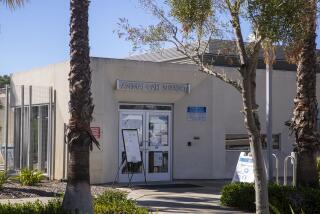L. A. Schools Scolded for Dangers in Labs’ Cleanup
- Share via
The Los Angeles Unified School District violated state safety regulations during a cleanup of hazardous chemicals in science classrooms, state officials said.
CAL-OSHA, the state agency that monitors employee safety, found that a supply center in Van Nuys, used as the repository for chemicals retrieved from schools, was unsafe and that a temporary employee there was not trained to handle dangerous chemicals, said James Mason, district manager in CAL-OSHA’s Van Nuys office.
The problems at the center have been corrected by the district since four citations were issued in late August, and no fines were levied, Mason said. But, because of the incident, CAL-OSHA officials still “don’t have a feeling of confidence” in the school district’s safety operation, he said.
Sparked by Clerk’s Complaint
The state agency began its investigation in early May, when the temporary employee, a stock clerk whose position was replaced with a full-time position later that month, complained about conditions at the supply center and about his duties, which included cleaning spills of chemicals at schools, Mason said.
The employee Larry Di Leo, 32, of Thousand Oaks said in an interview Wednesday that he become upset by the large amounts of potentially dangerous chemicals that had accumulated at the supply center and was concerned that he was handling the chemicals without proper training.
Di Leo, who now works as a security guard, said he was asked to help clean up spills of such hazardous chemicals as mercury and sulfuric acid and to pick up cans of old ether, which might have been explosive.
There were no accidents or injuries, but “the cleanup program was mismanaged and could have led to hazards,” Di Leo said.
Temporarily Closed Center
A CAL-OSHA inspector visited the district’s Science Materials Center on May 9 and discovered more than 130 boxes and barrels of chemicals piled in a haphazard, dangerous way, Mason said. The state informed the county officials of the “mess,” he said, and county health and fire officials temporarily closed the center after citing the district for a number of violations of health, safety and fire codes.
“We distilled it down to two areas: inadequate training on spill cleanups and incompatible storage” of chemicals, increasing the possibility of fire or explosion, Mason said.
The specific violations cited in CAL-OSHA’s four citations included the lack of an emergency shower or eyewash fountain at the supply center, even though “the stock clerk of chemistry handled corrosive liquids on a regular basis,” he said.
The problems developed early this year after district officials decided to conduct an inventory of chemicals and safety equipment in science laboratories at the district’s 150 secondary schools, said Gerald Garner, the district’s secondary science specialist.
Site Used as Warehouse
The effort was coordinated through the district’s Science Materials Center, a small building on a campus used by four schools, including Birmingham High, that is used as a warehouse and distribution point for science materials for all district schools.
Seven inspectors were hired temporarily by the district’s Safety Section to canvass the laboratories, with orders to find dangerous, unlabeled or old chemicals that should be removed and disposed of, Garner said.
The inspectors found safety violations at more than half the district’s schools, including the presence of dozens of highly hazardous chemicals, a lack of safety goggles and a lack of eyewash stations.
Garner said the stock clerk was supposed to assist with cleanups at schools as “a minor part” of his job, but that, once the cleanup began last spring, that “became a major part.”
Worker Was Warned
Garner said that Di Leo was instructed, however, never to handle a chemical if there was a potential danger. “He was told, ‘if you find you are not properly equipped, you should back away from the situation,’ ” Garner said.
Jack Waldron, head of the school district’s safety section, which worked closely with Garner’s group on the cleanup and inventory, said that Di Leo was usually accompanied by a chemist from the Safety Section when calls came in about the presence of dangerous chemicals.
“He never indicated to me that he felt untrained,” Waldron said. “It’s not our policy to subject people to unsafe conditions.”
“We made some mistakes,” Waldron said. “Going in, we were somewhat naive. We knew there was a lot of junk out in those schools, but not this much.”
“It was a great idea to take all these hazardous materials out of the schools,” CAL-OSHA’s Mason said. “But then they really didn’t make great plans to get rid of them once they gathered them. . . .”
More to Read
Sign up for Essential California
The most important California stories and recommendations in your inbox every morning.
You may occasionally receive promotional content from the Los Angeles Times.










